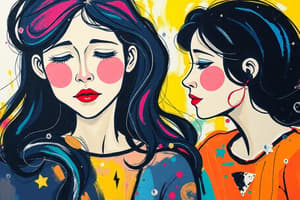Podcast
Questions and Answers
What does the Brana plan entail?
What does the Brana plan entail?
The Brana plan involves the targeting of women, adolescents, and children in Muslim communities during war, with the aim of destabilizing their social and religious structures.
What are three forms of mass rape described in the text?
What are three forms of mass rape described in the text?
- Military forces entering a village, raping women in public view, and then offering safe passage out of the village. 2. Random selection of individuals in concentration camps for rape, often as part of torture before death. 3. Imprisoning women in rape/death camps and subjecting them to systematic rape for extended periods of time.
What is the logic behind enforced pregnancies?
What is the logic behind enforced pregnancies?
Enforced pregnancies can be used as a form of torture and control, either preceding death or leading to forced pregnancy. It is a way to further inflict suffering on the victims and potentially contribute to the destruction of the targeted group.
What is the potential consequence of discussions focusing primarily on female victims of genocidal rape?
What is the potential consequence of discussions focusing primarily on female victims of genocidal rape?
What is the definition of a child soldier according to the international community?
What is the definition of a child soldier according to the international community?
What are some reasons why children become involved in armed conflict?
What are some reasons why children become involved in armed conflict?
Is there voluntary recruitment in the case of child soldiers?
Is there voluntary recruitment in the case of child soldiers?
Why is education considered essential for children who have experienced the trauma of civil war?
Why is education considered essential for children who have experienced the trauma of civil war?
How is education seen as a 'life-affirming activity' for children affected by war?
How is education seen as a 'life-affirming activity' for children affected by war?
What is the purpose of education from a child rights perspective?
What is the purpose of education from a child rights perspective?
What were some of the domestic responsibilities of girls in fighting forces?
What were some of the domestic responsibilities of girls in fighting forces?
What are some of the risks and health problems faced by girls associated with fighting forces?
What are some of the risks and health problems faced by girls associated with fighting forces?
What were some of the combat activities and related military functions performed by girls associated with fighting forces?
What were some of the combat activities and related military functions performed by girls associated with fighting forces?
How did the violence and victimization experienced by girls in fighting forces reflect the patriarchal power relations and gendered oppression?
How did the violence and victimization experienced by girls in fighting forces reflect the patriarchal power relations and gendered oppression?
What is the purpose of the retributive justice model in prosecuting child soldiers?
What is the purpose of the retributive justice model in prosecuting child soldiers?
What is the main goal of the restorative justice model in prosecuting child soldiers?
What is the main goal of the restorative justice model in prosecuting child soldiers?
Why might trying child soldiers in courts lead to difficulties with reintegration?
Why might trying child soldiers in courts lead to difficulties with reintegration?
What are some reasons why girls may choose to join armed forces?
What are some reasons why girls may choose to join armed forces?
How can rape and enforced pregnancy be viewed as a crime of biological warfare?
How can rape and enforced pregnancy be viewed as a crime of biological warfare?
What is the potential impact of direct attacks on civilian women and children in a conflict?
What is the potential impact of direct attacks on civilian women and children in a conflict?
How does the use of sperm as a weapon fit the concept of biological warfare?
How does the use of sperm as a weapon fit the concept of biological warfare?
How can enforced pregnancies contribute to the destruction and social death of a community?
How can enforced pregnancies contribute to the destruction and social death of a community?
What health issues do war-affected girls often experience post-conflict?
What health issues do war-affected girls often experience post-conflict?
How do social exclusion and community rejection impact the reintegration of girl child soldiers?
How do social exclusion and community rejection impact the reintegration of girl child soldiers?
How do spiritual and religious rituals facilitate the reintegration of war-affected children?
How do spiritual and religious rituals facilitate the reintegration of war-affected children?
What educational challenges do girls face in the aftermath of conflict?
What educational challenges do girls face in the aftermath of conflict?
Flashcards are hidden until you start studying
Study Notes
The Brana Plan and Genocidal Rape
- The Brana plan was endorsed by military officers, distinguishing Serbian rapes from those committed by Bosnians and others.
- Not all war rapes are committed with genocidal intent, and not all aim to destroy groups to which the victims belong.
- Serbian officers targeted women, adolescents, and children, the most vulnerable spots in social and religious structures of Muslim communities.
Forms of Mass Rape
- First form: Military forces enter a village, rape women of varying ages in public view, and then offer safe passage to residents to cleanse the area.
- Second form: Persons held in concentration camps are chosen to be raped, often as part of torture preceding death.
- Third form: Women are imprisoned in rape/death camps and raped systematically for extended periods.
Enforced Pregnancies and Genocide
- The intent of Serbian rapists appears to have been to produce Serb children, altering the identity of the next generation and the community.
- Military rape aimed at enforced pregnancy in rape/death camps was committed with genocidal intent.
- Forced pregnancies could become genocidal due to misogynous cruelties of the culture to which the women belong.
Biological Warfare
- Genocidal rape can be viewed as a crime of biological warfare, aiming to destroy the morale of a people.
- Rape and enforced pregnancy can contribute to the destruction of a community and the undermining of the will to fight.
- The use of sperm as a weapon fits the concept of biological warfare, attacking a biological system (reproductive system) in members of the enemy population.
Male Genocidal Rape
- The 1948 Convention definition of genocide was gender-neutral, but the dialogue surrounding it is often female-centric, neglecting male victims.
- Male prisoners in Serbian detention camps were subjected to castration and psychological damage, amounting to enforced sterilization, which could be considered genocide.
Child Soldiers
- The international community defines a child soldier as any person under 18 who is part of an armed force or group in any capacity.
- Problems with defining a child soldier: culturally constructed childhood, varying ages of maturity, and military participation as part of becoming an adult.
- Reasons for children becoming involved in armed conflict: forced recruitment, family considerations, power and glamour, disillusionment with failed systems, lack of education, and ideology.
Recruitment and Criminal Responsibility
- The recruitment process of child soldiers raises questions of voluntary recruitment and accountability.
- International community: children are victims of criminal policies, and should not be detained or prosecuted, but treated as victims by virtue of their age and forced nature of their association.
- Two models of justice: retributive and restorative justice, with differences in punishing wrongdoers, making restitution, and addressing the needs of victims and communities.
Girls in Armed Conflict
- Girls' involvement in armed conflict: voluntary recruitment, abduction, and manipulated recruitment.
- Roles of girls in armed groups: domestic work, sexual slavery, combat activities, and critical military functions.
- Victimisation, culture of violence, and insecurities experienced by girl child soldiers: physical abuse, verbal abuse, and patriarchal power relations.
Exclusion of Girl Child Soldiers from DDR Programming
- Girl combatants are often excluded from Disarmament, Demobilisation, and Reintegration (DDR) programming, which is characterized by gendered exclusion.
- DDR programming prioritizes male combatants, neglecting girls' military status and experiences.
- Girls experience 'spontaneous reintegration' without formal mechanisms of assistance, leading to difficult circumstances.
Health, Social Exclusion, and Educational Issues
-
Girl child soldiers face severe physical and psychological health problems post-conflict.
-
Social exclusion and community rejection hinder girls' reintegration into their communities.
-
Educational issues: girls often lack access to education, and their experiences are neglected in DDR programming.### Health Problems
-
Chronic head and stomach aches, war-related wounds, and beatings are common health problems among girls affected by war.
-
Malaria, tuberculosis, cholera, diarrhea, parasitic infections, and malnutrition are also prevalent health issues.
-
Gender-specific health problems include gynaecological problems, genital injury, infections, vesicovaginal fistula, and complications from self-induced or clandestine abortions.
-
Girls are at high risk for sexually transmitted diseases, including HIV/AIDS.
-
Devastating psychological after-effects of wartime sexual violence are common.
Social Exclusion and Community Rejection
- Family and community support are critical to war-affected children's long-term well-being and reintegration.
- Girls are often rejected by their communities due to their association with armed groups and experience of sexual violence.
- The way a girl was taken into a fighting force, her military role, and the way she returned to her community impact her reintegration.
- Behaviors learned in armed groups, such as aggression and abuse, can hinder reintegration.
- Girls are often deemed 'unmarriageable' following disclosures of rape due to the importance of virginity at marriage.
Spiritual and Religious Rituals
- Spiritual and religious rituals can facilitate healing, reconnect children to their communities, and promote social reintegration.
- Community-cleansing rituals can provide children with a feeling of acceptance, importance, and an opportunity to begin fresh.
- However, cleansing rituals may be exclusionary.
Educational Issues
- Thousands of girls and boys have no skills beyond those acquired in fighting or surviving the conflict.
- Girls are the least educated sector of the population in most developing countries.
- Education is essential for instilling stability and normalcy in the lives of children who have experienced trauma.
- Education is a significant 'life-affirming activity' that can restore hope and purpose among children who have been emotionally and physically overcome by war.
Studying That Suits You
Use AI to generate personalized quizzes and flashcards to suit your learning preferences.



